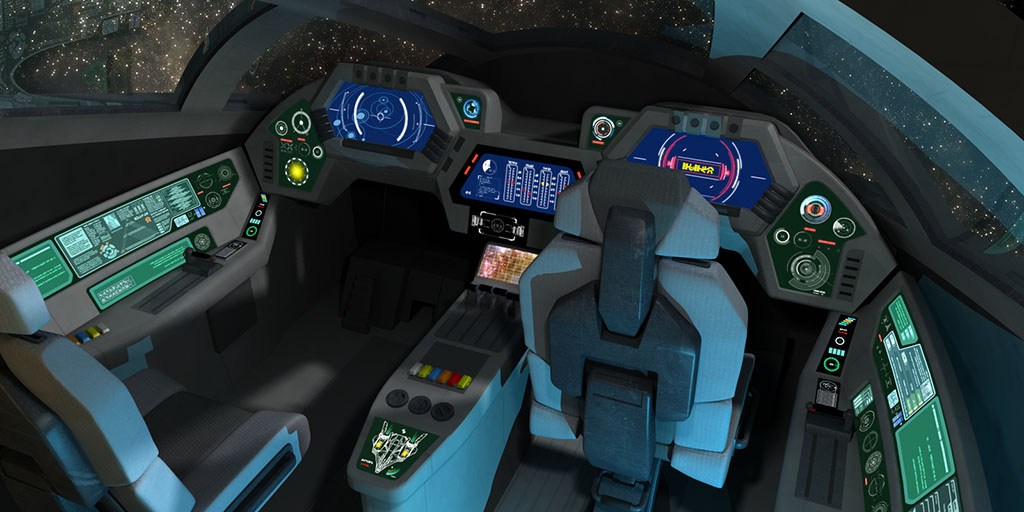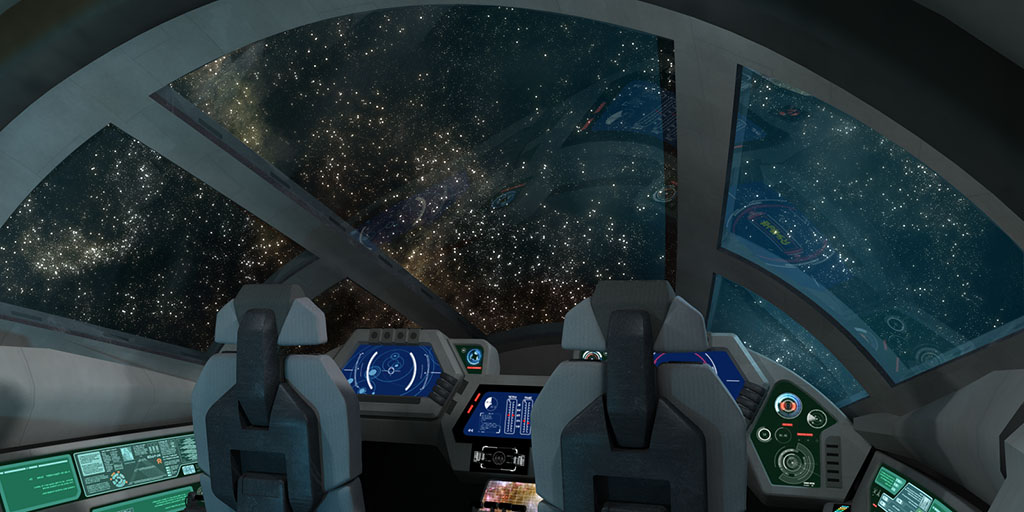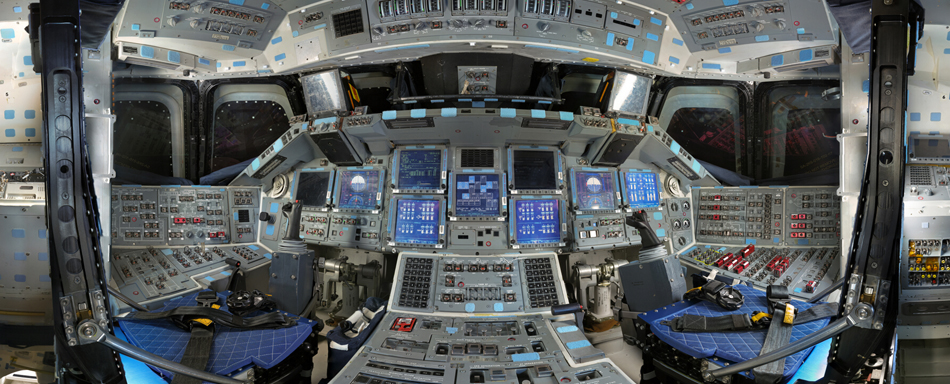Page 67 of 136
Re: WIP Discussion (Part 1!)
Posted: Fri Feb 24, 2017 3:13 pm
by ShadowDragon8685
Chekist_Felix wrote:sunphoenix wrote:Uhm.. hey Arioch... any news on when that new page update you mentioned might be finished? Not pushing or anything.. just wondering...you told us keep gently nudging and all...
Gently? He said to jump up and down on his head!

So... yeah, some update would be nice.
He was working on the next page last I heard of him in Discord. So with any luck, it's coming 27 February 2017.
Re: WIP Discussion (Part 1!)
Posted: Sat Feb 25, 2017 8:46 am
by Sweforce
The only really important motivation needed is the fact that Paetron donations are by page.

Re: WIP Discussion (Part 1!)
Posted: Mon Mar 27, 2017 6:54 am
by Krulle
[color=red]Arioch[/color] wrote:It's been a bit of remedial 3D modeling course, but I'm finally starting to make some headway.

Wow, that shuttle cockpit looks great.
It'll be even better when Alexander gets to access the navigational and star map data, I am sure.
I also love how the middle console screen at the lowest end looks like a wolf's head.
Re: WIP Discussion (Part 1!)
Posted: Mon Mar 27, 2017 11:46 am
by sunphoenix
OH MY.... wow Arioch...That's Beautiful! Always worth the wait to see your artistry really SHINE!

Re: WIP Discussion (Part 1!)
Posted: Mon Mar 27, 2017 2:45 pm
by Whale
Those support beams seem to block visibility pretty badly...
Re: WIP Discussion (Part 1!)
Posted: Mon Mar 27, 2017 4:19 pm
by sunphoenix
Whale wrote:Those support beams seem to block visibility pretty badly...
But honestly, in the vastness of space... visual navigation is mostly worthless, most navigation is done via the sensor returns.
Re: WIP Discussion (Part 1!)
Posted: Mon Mar 27, 2017 8:00 pm
by NuclearIceCream
Its also not a combat vehicle. So having a massive and unobstructed view of the shuttles immediate surroundings is entirely unnecessary.
Re: WIP Discussion (Part 1!)
Posted: Mon Mar 27, 2017 8:47 pm
by icekatze
hi hi
I think the wolf's head image is the silhouette of the shuttle from above or below. Possibly an overview systems condition monitor?
Compared to the old US space shuttle, the view from the front window is relatively unobstructed. I'm sure the Loroi have more advanced materials which make that possible.
Re: WIP Discussion (Part 1!)
Posted: Tue Mar 28, 2017 3:02 am
by ShadowDragon8685
icekatze wrote:hi hi
I think the wolf's head image is the silhouette of the shuttle from above or below. Possibly an overview systems condition monitor?
Compared to the old US space shuttle, the view from the front window is relatively unobstructed. I'm sure the Loroi have more advanced materials which make that possible.
It also unquestionably has enough Δv and thrust that an Orbiter-style near-orbital-velocity aerobraking won't be necessary; they can just burn main engines retrograde and drop their velocity enough that they won't build up anywhere near the kind of plasma-generating air-friction that the Orbiter did on its return, so they don't need to protect the cockpit windows as much from heat.
Re: WIP Discussion (Part 1!)
Posted: Tue Mar 28, 2017 4:18 am
by icekatze
hi hi
I think the shuttle's delta v is absolutely questionable. Arioch has stated that the main engines are only usable in space, and that the secondary engines are mainly used for ascent in an atmosphere. While they can probably do a powered descent, sounds like they do at least sometimes make use of aerobraking. The fuel for the secondary engines is much more limited than the main engines.
Re: WIP Discussion (Part 1!)
Posted: Tue Mar 28, 2017 8:45 am
by Krulle
That's not really an issue in space. The distances are so vast, that the only visible things you need are your screens.
The windows are likely more for your personal mental benefit.
Heck, in most SciFi stories I read the windows are not real, but monitors showing a camera view. If need be they could magnify, or even switch to other vital information. But it gives your mind a more restful mindset when seeing the stars like that.
Re: WIP Discussion (Part 1!)
Posted: Tue Mar 28, 2017 10:27 am
by SVlad
icekatze wrote:hi hi
I think the shuttle's delta v is absolutely questionable. Arioch has stated that the main engines are only usable in space, and that the secondary engines are mainly used for ascent in an atmosphere. While they can probably do a powered descent, sounds like they do at least sometimes make use of aerobraking. The fuel for the secondary engines is much more limited than the main engines.
It obviously has enough dV to drop from orbital 8 km/s to relatively safe 1 km/s and just fall in atmosphere instead of long aerobreaking at hypersonic speed.
Re: WIP Discussion (Part 1!)
Posted: Tue Mar 28, 2017 7:38 pm
by icekatze
hi hi
Perhaps it has the delta v to drop straight into the atmosphere at a steep angle, but there are other problems with taking that kind of reentry profile. The Highwind is big enough to have inertia dampening at least, but other smaller craft may not be so fortunate. Dropping something into the atmosphere from zero velocity has a tendency to create some extremely high g forces.
Re: WIP Discussion (Part 1!)
Posted: Wed Mar 29, 2017 12:20 am
by man_of_foul_tofu
Lovely to see some beautiful new highly detailed and bloody delightful 3D material appearing in the Work in Progress thread.
I think it is beautiful.

Re: WIP Discussion (Part 1!)
Posted: Wed Mar 29, 2017 11:32 am
by SVlad
icekatze wrote:Dropping something into the atmosphere from zero velocity has a tendency to create some extremely high g forces.

extremely high g forces appears, when object dives into atmosphere with almost orbital speed and aerobrakes there. That's case for all spacecrafts IRL. And if you fall with zero orbital velocity, you should end with less than 3 mach in upper atmosphere.
Re: WIP Discussion (Part 1!)
Posted: Wed Mar 29, 2017 1:10 pm
by ShadowDragon8685
icekatze wrote:hi hi
Perhaps it has the delta v to drop straight into the atmosphere at a steep angle, but there are other problems with taking that kind of reentry profile. The Highwind is big enough to have inertia dampening at least, but other smaller craft may not be so fortunate. Dropping something into the atmosphere from zero velocity has a tendency to create some extremely high g forces.
I think you're completely backwards here.
It's doing an Orbiter-style slamming-into-the-atmosphere-at-orbital-velocity approach to deorbiting that creates extremely high G-force.
If you have enough Δv - and let's face it, even Terran ships are going to have in Outsider - you can, as I said, just burn retrograde. You'll shed your orbital momentum rapidly, and drop relatively straight downward. Instead of a hypersonic reentry profile that creates a plasma shield and threatens to torch your whole spaceship, you'll have a merely supersonic reentry profile that, frankly, human aircraft have been able to handle this since 1963 - the
North American X-15 is a rocket-powered spaceplane that was capable of achieving suborbital flight and returning to Earth. A great many aircraft we have
today could survive such a reentry profile and make a powered landing, if, for some absurd reason, they found themselves suddenly at that altitude and heading back groundward.
For any Loroi shuttle with more than the most
rudimentary aerodynamic controls and air-breathing engines, this would be literally a routine flight maneuver. The
Highland shuttle has full aerodynamic controls and air-breathing vector-thrust engines, so dropping velocity and making a supersonic reentry should be ordinary for it.
Re: WIP Discussion (Part 1!)
Posted: Wed Mar 29, 2017 5:29 pm
by icekatze
hi hi
I don't think I'm completely backwards here, and I think it is a matter of scale. Steep insertion angles produce higher g-forces than shallow angles, for any given re-entry velocity. The X-15, with it's re-entry angle of about 20-23º experienced 5g during pullout.
Unless you're doing retrograde burns during entry, there will be some substantial g loads and/or heating considerations. But this was not meant to be an argument about what kinds of heating tiles the Humans or Loroi have, and whether or not this is something they could do regularly. The 600ºC temperatures the X-15 experienced and the 1200ºC temperatures the space shuttle experienced, and the 2760ºC temperatures the Apollo capsules experienced were clearly workable.
The crux of my argument was about the material science required to subject the
windows of the craft to pressure changes, temperatures, and stresses without being obstructed by supports. By comparison to any contemporary human space craft, the windows on the Highwind are spacious.
Re: WIP Discussion (Part 1!)
Posted: Wed Mar 29, 2017 6:04 pm
by Arioch
I'd never seen the X-15 cockpit open before; that's an insanely tight fit for the pilot. I never built an X-15 model (unlike most other military aircraft), so I didn't really grasp how small the plane is.
The
Highland's exo-atmospheric drives give it 20
g acceleration; it's hard to imagine a survivable aerobraking velocity that couldn't easily be countered by such engines. But since the entry configuration is belly-down, like the space shuttle, I doubt the windows will be the point of failure. The struts are large because the windows are large; that's a big open area. In hindsight, the twin seat configuration would be better supported by having a strut down the center, but that didn't look nearly as cool when I was drawing from the outside. But they can still see out just fine.

Here's how much visibility you need to land a real shuttle:


Re: WIP Discussion (Part 1!)
Posted: Wed Mar 29, 2017 7:27 pm
by ShadowDragon8685
icekatze wrote:I don't think I'm completely backwards here, and I think it is a matter of scale. Steep insertion angles produce higher g-forces than shallow angles, for any given re-entry velocity. The X-15, with it's re-entry angle of about 20-23º experienced 5g during pullout.
Unless you're doing retrograde burns during entry, there will be some substantial g loads and/or heating considerations.
The thing is that unless you're doing a fully-powered descent, reentry velocity and angle are to some degree related to one another. The G-forces of doing a belly-flop, having killed your orbital velocity from 8Kms to 1Kms, or even 500m/s, are going to be absolutely negligible compared to the g-forces of doing an Orbiter-style aerobrake. With the kind of delta and TWR a Highland shuttle has, there's no reason
not to do this, because it gives you the best control over where you land.
The crux of my argument was about the material science required to subject the windows of the craft to pressure changes, temperatures, and stresses without being obstructed by supports. By comparison to any contemporary human space craft, the windows on the Highwind are spacious.
Right, but we can also assume that their windows are going to be, at minimum, synthetic sapphire, and the hull is going to be similarly more tough. As long as they aren't smacking the atmosphere nosefirst at Apollo speeds, they're gonna be
just fine.
Arioch wrote:I'd never seen the X-15 cockpit open before; that's an insanely tight fit for the pilot. I never built an X-15 model (unlike most other military aircraft), so I didn't really grasp how small the plane is.
It can be fairly accurately described as a semiballistic air-to-ground cruise missile with a guidance system consisting of one (1) test pilot and no warhead.
The Highland's exo-atmospheric drives give it 20g acceleration; it's hard to imagine a survivable aerobraking velocity that couldn't easily be countered by such engines.
I thought that using your sublight main drives in or near an atmosphere was a huge environmental no-no? (Though I imagine that given the choice between filling out paperwork for an environmental contamination event and dying horribly, most pilots would choose the former.)
But since the entry configuration is belly-down, like the space shuttle, I doubt the windows will be the point of failure. The struts are large because the windows are large; that's a big open area. In hindsight, the twin seat configuration would be better supported by having a strut down the center, but that didn't look nearly as cool when I was drawing from the outside.
Aren't the main drives basically fixed solely to the aft? I mean, some vectoring can be expected and all, but still; if you're using the main drives to counter reentry, you're probably not in standard entry configuration.
Anyway, well... The Loroi are probably no less given to making some minor performance compromises in the name of Rule of Cool than we are, so using a side-by-side strut window in a side-by-side seat configuration could just be explained away as a minor design flaw.
Or maybe the Highland was originally slated for a tandem-seat flight configuration, which got changed but too late in the design process to change the cockpit strutting.
Re: WIP Discussion (Part 1!)
Posted: Wed Mar 29, 2017 8:04 pm
by icekatze
hi hi
If a space craft cancelled it's orbital velocity and fell straight down, it would accelerate at close to 9.8 m/s until it reached parts of the lower atmosphere (between 5000 and 1000 meters on Earth, depending on aerodynamics) where it would decelerate rapidly. Objects entering the atmosphere at steep angles tend to follow a logistic function of deceleration, with around 90% of the deceleration happening in as little as 10 seconds, even for objects moving at orbital speeds. 12g is certainly survivable, but it isn't negligible.
Sapphire glass is certainly heat resistant and hard, but it is also brittle. Not sure if it would make a good material for a combat capable vessel.
As long as they aren't smacking the atmosphere nosefirst at Apollo speeds, they're gonna be just fine.
I must admit, this confuses me. Do you think I am suggesting that they won't be fine? That was never my assertion. My assertion was that the Loroi probably have more advanced materials than we humans currently have.
So... yeah, some update would be nice.




